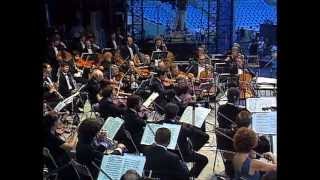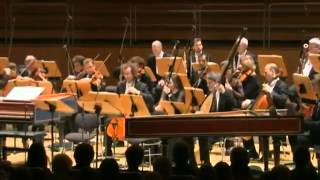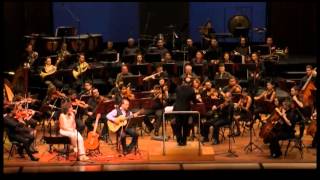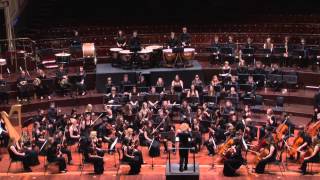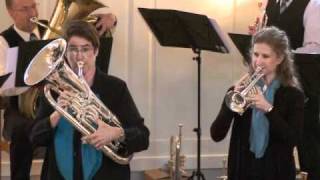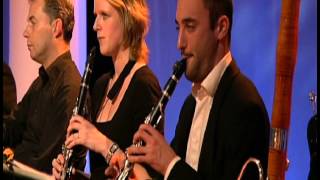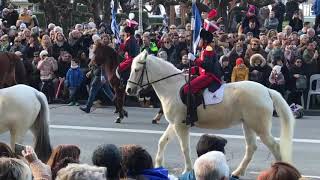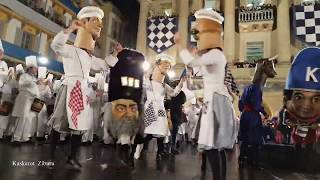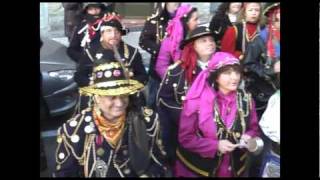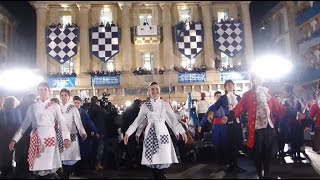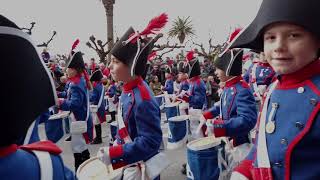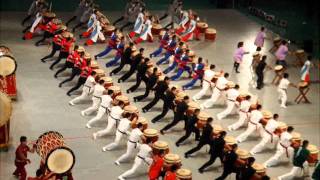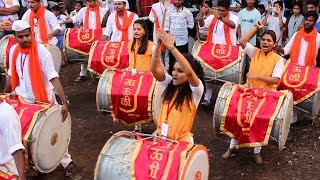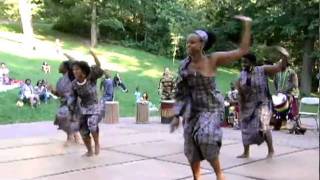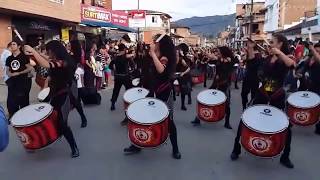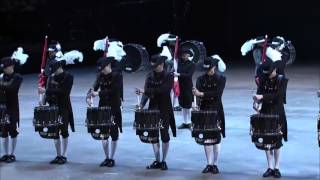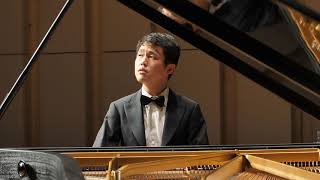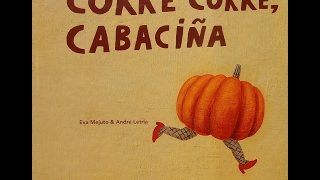On (19 night) January 20 the Tamborrada of Donostia is celebrated
Recommended music videos for initiation to classical music
La Tamborrada de San Sebastián is the drum festival with which Donostia celebrates its patron saint, San Sebastián , starting at midnight on January 20. In the year 1597 there was a plague epidemic in Pasajes , then a neighborhood of San Sebastián ; The neighbors went to the Church of San Sebastián to direct their prayers; the epidemic was disappearing and the neighbors took him as Patron of the city promising to celebrate his date. La Tamborrada was at first a prelude to Carnival , since already in 1835 a carnival troupe, in which each one dressed up as they pleased, would leave around five in the morning on the 20th as a reveille; For this comparsa Sarriegi composed his tamborrada works that he would extend to other Carnival comparsas.
Today, the party begins at midnight on January 20 in the Plaza de la Constitución with the hoisting of the city's flag and the interpretation of the March of San Sebastián to end at midnight. In this video we offer the San Sebastián March by maestro Sarriegi in a version by the Orfeón Donostiarra accompanied by the Euskadi Symphony , under the direction of Víctor Pablo Pérez .
Raimundo Sarriegi (1813-1913) was a musician from San Sebastian who was born at the end of the first Carlist war into a family of farmers. He was a disciple of the teacher José Juan Santesteban the "maixua" and his favorite student. He composed abundant music for the Donostiarra Carnival, he also wrote other types of musical works such as the zarzuela “ Pasayan” or “Petra Chardiñ saltzallia ”; He also composed works for choir, such as " Beti maite " or " Illunabarra ", for txistu as a " Contrapás ", a " Minueto ", or the well-known " Alkate soñua " that today is performed by the Municipal Band of Txistularis when it accompanies the Town Hall . San Sebastian in corporation. Today it has a square and a monument in his honor in the Old Town of San Sebastián .
Jean-Baptiste Lully (1632-1687) was a French composer of Italian origin (he was born in Florence ) and naturalized French at age 21 (his real name was Giovanni Battista Lulli ). He soon stood out as a violinist and dancer and at the age of twenty he became part of Louis XIV 's service as musical director of the royal family; from then on, its importance in the development of classical ballet has been paramount. It also renewed the essence of the opera with greater solemnity in its staging, a decided emphasis on the clarity of the text and careful preparation in the ballets and choruses of the same. His musical production is fundamentally based on three pillars: opera, ballets and religious music.
Le Bourgeois Gentilhomme ( The Bourgeois Gentleman ) is a comedy-ballet by Molière in five acts with music by Jean-Baptiste Lully ; it was premiered by Molière 's company on October 14, 1670 at the court of Louis XIV at the Château de Chambord .
Today we offer the March for the ceremony of the Turks performed by the Frankfurt Radio Symphony under the baton of the master harpsichordist and conductor specializing in baroque music, Emmanuelle Haïm , who has had relevant performances in front of the Berlin Philharmonic, from the Chicago Opera or the BBC Proms , among other formations.
Ernesto Lecuona Casado (1896-1963) was a Cuban music performer and composer, son of journalist Ernesto Lecuona Ramos , originally from the Canary Islands who had settled in Cuba , a Spanish province at the time. He was a child prodigy, he gave his first recital at the age of 5 and at 13, he made his first composition. She graduated from the National Conservatory of Havana with a gold medal in acting when she was 16 years old. Outside of Cuba , he began his career at Aeolian Hall (New York) and continued his studies in France with Maurice Ravel . Lecuona 's most important contribution to the theatrical genre is the definitive formula of the Cuban romance and he is considered one of the most outstanding Cuban musicians.
Malagueña is the sixth movement of the Suite Andalucía (1933) composed by Ernesto Lecuona (1895-1963), who also composed its lyrics in Spanish. This song has since been adapted to genres of pop, jazz, and band music (military and bugle and drum) and lyrics have been composed for it in various languages. Today we see it in a version for accordion performed by the Latvian accordionist Ksenija Sidorova .
The Beatles , was a British rock band formed in Liverpool during the 1960s, being integrated from 1962 to its separation in 1970 by John Lennon, Paul McCartney, George Harrison and Ringo Starr . It is considered one of the most influential bands of all time, being a fundamental part of the development of the counterculture movement of the 1960s. Rooted in skiffle, beat music and rock and roll of the 1950s, the band would reach to work with a wide range of musical styles, ranging from ballads and Indian music, to psychedelia and hard rock, coming to be perceived as the embodiment of the progressive ideals of the youth of the time and their social movements and cultural.
According to RIAA certifications, they have sold more records in the United States than any other artist. They were awarded seven Grammy Awards , receiving a total of fifteen Ivor Novello Awards . In 2004, Rolling Stone magazine ranked them number one on its list of the "100 Greatest Artists of All Time". In 2010, VH1 ranked them number one on its list of the "100 Greatest Artists of All Time". They were also ranked number 1 by the website. Acclaimed Music in its list "The Top 1000 Artists of All Time". They also appear in the first position as the greatest artists of all time on the Hot 100 and Billboard 200 lists in the 2015 Billboard ranking.
Today we are witnessing the performance of a florilegium of some of his best songs offered by Claudia Gómez (voice and guitar), Julián Cardona (Guitar) and the Medellín Philharmonic Orchestra under the direction of maestro Gonzalo Ospina .
Recommended classical music videos
Wolfgang Amadeus Mozart (1756-1791) is considered one of the three giants of musical composition along with Bach and Beethoven . Child prodigy born in Salzburg , at the age of six he mastered the keyboard and the violin and began to compose. His father, Leopold exhibits him in exhausting tours of different European courts. A prolific composer (more than 600 works written from the age of five until his death), he cultivated all kinds of musical genres: piano works, chamber music, symphonies, concertante works, choral works, operas... each and every one of them, masterpieces of its gender. His operas The Magic Flute, Don Giovanni, Cosí fan Tutte, and The Marriage of Figaro are among the 10 most performed operas in the world. He died in Vienna at the age of 35.
Don Giovanni The punished libertine or Don Juan (original title in Italian, Il dissoluto punito, ossia il Don Giovanni ) is a jocular drama in two acts with music by Wolfgang Amadeus Mozart and Italian libretto by Lorenzo da Ponte based on the original work The trickster of Seville and stone guest of Tirso de Molina . It premiered at the Prague Theater on October 29, 1787. Although sometimes classified as comic, it mixes comedy, melodrama, and supernatural elements. It appears as number seven on Operabase's list of the most performed operas worldwide, and Mozart's third, after The Magic Flute and The Marriage of Figaro . The work, whose plot takes place in Seville , is a reworking of the literary theme of Don Juan .
Claudio Abbado (1933-2015), Italian conductor considered one of the greatest of our time, has been Music Director of the Teatro alla Scala in Milan , Principal Conductor of the Vienna Philharmonic , Head of the London Symphony Orchestra , Music Director of the Vienna State Opera, General Director and Artistic Director of the Berlin Philharmonic Orchestra. He was also the founder and musical director of the Youth Orchestra of the European Union and the Gustav Mahler Youth Orchestra and maintained a close relationship with the System of Youth and Children's Orchestras of Venezuela, repeatedly conducting the Simón Bolívar Symphony Orchestra in Caracas . and in different cities of Europe and USA .
Hector Berlioz (1803-1869) was a French composer, an eminent figure in program music and romanticism in general. His father, a doctor, sent him to Paris to study medicine; but he abandoned medicine and enrolled in the Paris Conservatoire where he studied composition. From here to Rome where, while on a scholarship, he wrote several operas, symphonies, overtures, various songs and choral works. He took notice of the hymns of his teacher, Jean-François Lesueur , and did a lot of imitation of Beethoven , then unknown in France ; also Gluck, Mozart, Étienne Méhul and Carl Maria von Weber. In 1844 he composed the first known work for saxophone, the Canto Sagrado sextet, which was premiered under the baton of Berlioz himself and with Adolphe Sax on saxophone.
Fantastic Symphony , op.14, subtitled Episode from the Life of an Artist , consists of five movements:
I (0´8´´) DREAMS AND PASSIONS, describes the anxiety produced by the protagonist before meeting his beloved, later the volcanic love that she inspires in him. Towards the end of this movement, we perceive a contrast between the passion produced by the protagonist and the grief caused by the rejection.
II (14'07'') A DANCE, there is a reunion with the beloved after the rejection, in a dance. The music then adopts the tempo of a waltz, thus describing the restlessness of the protagonist. The "fixed idea" appears briefly interrupting the waltz, reappearing at the end of the movement.
III (20´48´´) SCENE IN THE FIELD . It describes two shepherds, represented by the duo formed by the English horn and the oboe, enjoying a wonderful summer afternoon. Towards the middle of the movement, the beloved appears and he is invaded by terrible premonitions. At the end the English horn reappears, again evoking the pastoral theme and ending with a timpani roll, which produces a mysterious climate.
IV (36´34´´) THE MARCH TO THE GADALSO. The musician dreams that he kills his beloved and, therefore, is sentenced to the guillotine to be executed; at that moment he remembers for the last time the feeling of love. The march is based on two main themes each interpreted by the strings and the winds. The movement ends with drum rolls and timpani along with chords played by the brass winds symbolizing the power of justice.
V (41´47´´) DREAMS OF A COVEN NIGHT. The protagonist witnesses his own funeral, surrounded by witches and spirits among which he can see the beloved transformed into a harpy. The Dies Irae ( 12th century melody belonging to the Gregorian chant, and which is part of the Requiem ) is introduced in the work together with the round of the witches accompanied by the ringing of the bells. (Extracted from Digital music lover).
Jean Baptist Arban (1825 - 1889) was a French cornetist, conductor and pedagogue, who was influenced by Niccolò Paganini 's virtuoso technique on the violin and made an attempt to use the cornet as a true solo instrument. He was appointed professor of saxhorn at the Military School in 1857 and professor of cornet at the Paris Conservatoire in 1869. He published Grande méthode complète pour cornet à pistons et de saxhorn in Paris in 1864 which is still used by modern players. His variations on the theme " Carnival of Venice " remain one of the benchmarks for modern cornet and trumpet soloists.
Arban 's Brilliant Fantasy , featured today, is an arrangement by Chris Woods for trumpet, euphonium, and brass ensemble performed by Angie Hunter , Ashley Hall , and the Eurobrass brass ensemble.
Darius Milhaud (1892–1974) was a French composer noted for his use of polytonality and rhythmic patterns derived from jazz. In 1916 he traveled to Brazil as secretary of Paul Claudel , then ambassador; there he writes the Saudades do Brasil , Scaramouche , Le Bœuf sur le toit and the choreographic poem L'Homme et son desir . In 1918 he returned to France , befriended Erik Satie and became part of the Group of Six . In 1940 he fled from the occupation of France by the Nazis and moved to the USA , where he remained until 1947 to work as honorary professor of composition at the Paris Conservatoire . He wrote more than 400 works of all kinds of musical genres from chamber music to choral works, symphonies, operas, incidental music...
Concerto for Percussion and Small Orchestra is one of the first concertos written for a percussion soloist, and it is one of the most performed pieces in the repertoire. In this work he countered the jazz style by composing it in a polytonal way, while the percussion ideas are not composed with a solo approach; rather, the entire percussion section is played by a single person. It consists of two movements: I (0´21´´) VIF, RUDE ET DRAMATIQUE Hard and dramatic movement based on polytonal harmonies. II (3'09'') MODERÉ. Lyrical movement, contrasting with the previous one and carried out by small solos of different instruments interrupted in the final section by reduced memories of the initial theme. (Excerpted from the article by Elizabeth Kosko, 2010)
As a soloist today we are joined by master percussionist Laura Trompetter .
Drums of Donostia
Drums of the world
Recommended music videos for children
Various Wikipedia articles have been used to write these texts.
The texts of Videomusicalis are written in Basque, Spanish and English.





